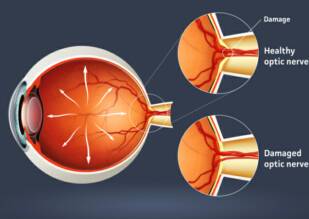15925 E. Whittier Blvd. Whittier, CA 90603
1 block East of the Whittwood Town Center
Glaucoma
What causes glaucoma?
Clear fluid (called the aqueous humor) circulates through the eye providing regulated pressure to help maintain the shape of the eye. A healthy eye will produce aqueous humor at the same rate that the fluid is drained. However, if the drainage area for the aqueous humor (called the angle) is blocked, the fluid cannot flow out. When this happens, the aqueous humor is unable to recycle normally and pressure begins to build up in the eye. This increased pressure pushes against the optic nerve, causing potential damage.
What are the different types of glaucoma?
Open-angle Glaucoma is the most common form of glaucoma. It accounts for over 90% of all cases, and the risk of developing it increases with age. With open-angle glaucoma, the angle of the iris and cornea remains open, but the aqueous fluid drains too slowly. This causes an increase in eye pressure, potentially damaging the optic nerve. This type of glaucoma produces no tangible symptoms in the early stages. In fact, it progresses so slowly and painlessly that unless you have been receiving annual eye exams, you may not be aware of any vision loss until the optic nerve is already damaged.
Angle-closure Glaucoma is substantially more serious than open-angle glaucoma. It occurs when the angle of the eye becomes completely blocked, causing eye pressure to build up suddenly with noticeable symptoms. These may include severe pain, headache, blurred vision, or nausea. Contact an ophthalmologist immediately if you experience any of these symptoms. Closed-angle glaucoma has the potential to cause vision loss within a day of its onset and can result in blindness if not treated quickly.
Who is at risk for glaucoma?
While there is no established cause of glaucoma, certain individuals are at a higher risk for developing the condition. Common risk factors include:
- Age 45+
- Family history of glaucoma
- People of African, Hispanic, Asian, or Scandanavian descent
- Previous eye injury
- Diabetes
- Regular, long-term steroid/cortisone usage
- Nearsightedness (Myopia)
How is glaucoma treated?
These treatments include:
Medical and Laser Treatment:
Open-angle glaucoma can often be controlled with a simple in-office laser procedure (Selective Laser Trabeculoplasty or SLT), or with eye drops taken on a daily basis. Most patients with open-angle glaucoma are treated with the SLT procedure by Dr. Marshburn to eliminate or reduce the need for daily prescription eye drops.
Surgical Treatments
If laser or eye drop therapy is ineffective, surgery may be required to control eye pressure. The procedures available are:
- Ex-Press Shunt, in which a small tube is inserted to relieve eye pressure.
- Trabeculectomy, which creates a surgical opening to lower the eye pressure.
Remember, loss of vision due to glaucoma can be prevented. Regularly scheduled eye examinations are the best insurance against glaucoma.
(562) 947-8681
Excellence in Eye Care for over 50 years
Glaucoma is a leading cause of blindness, especially for the elderly. Two million Americans over the age of 40 are afflicted with this eye disease, called “the silent thief of sight” because it often causes permanent vision damage without any obvious symptoms or warning.
For this reason, it is critically important to schedule regular eye exams: loss of sight from glaucoma can be slowed or prevented with early diagnosis and treatment.
What is glaucoma?
Glaucoma is a disease of the eye involving progressive damage to the optic nerve. The optic nerve consists of millions of nerve fibers which carry visual images to the brain. When pressure inside the eye increases, these fibers may be damaged, causing blind spots to develop. If the entire nerve is destroyed vision will be lost completely.
Copyright 2011: Marshburn Eye Center. Eye Doctor Orange County. All rights reserved.
15925 E. Whittier Blvd. Whittier, CA 90603 (562) 947-8681










